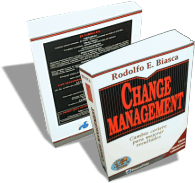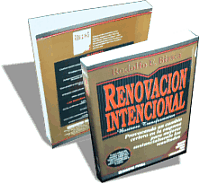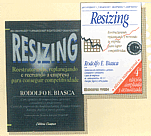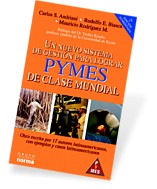|
|
Books
There is no other Spanish speaking author that has published so extensively in the competitiveness improvement / business innovation / business transformation/ change management field. |
|
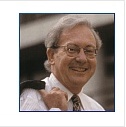 |
Criteria.
Evidence of the R.Biasca’s authorship of scholarly articles in the field, in professional or major trade publications or other media.
The evidence is overwhelming: author of 15 books (10 as sole author and 3 as co-author), 42 research booklets, and more than 140 papers. The amount of published material in paper exceeds 10,000 pages. The first article was published in 1974, more than 30 years ago; the first book was published in 1976 and the last some months ago (October, 2005). Books are kept in libraries of different countries (12 books are in the US Library of Congress) and online bookstores have made them available all over the world.
In this chapter, I will:
- Explain the main publications, focusing the comments in some books.
- Present evidence that my publications were recognized as valuable.
- Include evidence that the books are mentioned in relevant publications, media and libraries.
- Demonstrate the commercial success achieved as author.

No effort has been done to prove that booklets and papers were published, the relevance of the fifteen books made that task unnecessary.
I, R. Biasca, am the author of 15 books (12 as sole author and 3 as co-author), 42 booklets, and more than 140 papers. The work includes research studies, business models development, practical advice, recommendations and guides, general articles.
Different studies have demonstrated that change efforts results are less than satisfactory. Therefore, a comprehensive, interdisciplinary and practical three-phase model is proposed (known in Latin America as the “Biasca’s Model). The purpose is to determine the precise transformation that can improve results substantially. This model has evolved slowly and be refined over the years: in the 2004 books is more comprehensive than in the book published in year 1998.
To prove the breath and the high nature of my work, I will focus some comments in the most important books:
- My main books are a set of three books dedicated to a holistic approach to the business transformation subject:
- "Are we competitive?” (October 2001,2002, 2004)
- “Results. The Formula” (2000, 2004)
- “Results. Action” (2000, 2004
They have a total of more than 1,600 pages. A brief description follows:
Title |
Contents |
Date
|
Are we competitive?
Strategic Analysis to Create Value. |
Competitive Assessment.
After analyzing the environment and the firm, the competitive deterioration is estimated to determine how much change is needed and how much time is available to make the change. |
2004 |
Results.
The Formula, to grow in a competitive environment. |
Innovation
After an exhaustive study of change approaches, research on the subject and managerial experience a general business transformation “formula” is derived. For each competitive situation the formula is different (and usually different names are used to mention it). The formula is a set of innovation projects with different priorities and impact. |
2004 |
Results.
The Action.
From ideas to concrete facts. |
Execution
To transform ideas in concrete results at least four aspects need to be considered: the necessary implementation steps, how to modify human and firm behavior, the competitive position and the country where the organization is located.
Most Latin American managers assume that what is true for Americans working in the United States is also true for people from other countries. Sometimes it is not. Cross-cultural management applied to change management concepts is a new field relative to the traditional study of management. The book emphasis this point. |
2004 |
| These three books have an Internet appendix: www.biasca.com/results. Books can be seen in the publisher’s website (www.granica.com; searching with my name as author you reach www.granicaeditor.com/autor.asp?id=270 ) |
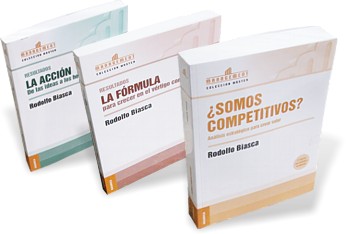 |
The previous work was in two books: |
| ”Change Management” (1998, with an Internet Appendix: www.biasca.com/change). It was the first business e-book published by an Argentinean author (in www.e-libro.net). |
|
| “Intentional Renewals” (1997), |
|
”Resizing” (1991, 1995, 1997, 1998; published in Portuguese in 1995; available as e-.book in www.biasca.com since 2002) was an all-time bestseller, following the success of “Downsizing” (1989), the first book in Spanish on that topic. The book can still be seen in publishers’ websites:
http://www.macchi.com/default/index.asp; http://www.macchi.com/Catalogo/Libro.asp?Id=9505371519 ) and http://www.campus.com.br/ |
|
| ”Efficiency” (1988, 1994) was a distance-learning guide (two volumes, 1000 pages published by a university) that was written taking as a basis the book “Productivity” (1984). |
|
THE MOST RECENT BOOKS: |
The most recent books are:
- One that was written with the collaboration of 13 Latin American authors: “El Nuevo Sistema de Gestión para las PYMEs” (A New Management System for Small Business) published by Editorial Norma in Mexico , March 2003 for the Mexican and Central American market. With another approach and title (“Un Nuevo Sistema de Gestión para lograr PYMES de Clase Mundial”, A New Management System to achieve world-class small businesses) was published in Colombia , June 2003 for the South American market.
The publisher’s website is www.granica.com , and the books can be found searching with my name as author.
The book was a success and a second edition with more pages was published in September, 2004. |
|
| “More Competitive Small Business”, published by El Cid Editor in August 2005 as an e-book that can be printed on demand (see www.e-libro.net). |
|
| “Organizational Change and Improvement: Biasca’s Model” (October 2005), Outskirstspress, 700 pages, sold as book and e-book. See Exhibit 102. This a paperback edition made in the US that summarizes the three most important books and it is distributed to the whole world through numerous e-bookstores. |
|
All the prizes have taken into consideration the amount and the quality of the material published. One example of a specific recognition to the publications is the Argentine Council for Industrial Engineers Publications Award. .
This organization is an independent institution that belongs to the Argentine Government. It regulates the industrial engineering profession in legal matters and determines what professional is a Certified Industrial Engineer. The institution has a very few awards to recognize contributions to the IE profession. One of those awards is dedicated to publications, to the person that has published relevant material. I received that award in 1991.
- THE BOOKS ARE KEPT IN IMPORTANT LIBRARIES
As all the important libraries indicate, if a person donates books to a library those books are analyzed by librarians and, if they are relevant, they are kept in the library. Libraries analyze their stocks from time to time, books that are not used or that are no more valid are eliminated from collections. Consequently, if books are kept in important libraries and they are kept during a long period of time, they are valuable.
For the sake of demonstrating their relevance, the following is powerful evidence. R.Biasca’s books are kept in the most important US public libraries (like the Library of Congress), in the most important university libraries (such as Harvard or Chicago), and in different countries.
WorldCat is a world wide catalog created by more than 9,000 institutions (see http://www.oclc.org/worldcat/default.htm) that is used by libraries. It is not complete yet.
A first search with the name of Rodolfo Biasca indicated 20 “books” (there are some duplication in titles and some of the written “booklets” are classified as books.
It says that the book “Productivity” is in 15 libraries, in different countries (US, Spain , UK , etc.). Please, note that this book was published in 1984 and some of the libraries are well known ( Harvard University , University of Chicago , etc.).
- US Public Libraries.
Examples:
- US Library of Congress . www.loc.gov
Twelve books are mentioned and kept in the most important library in the world.
- Chicago Public Library. Three books are mentioned.
- Boston Public Library. One book.
- US University Libraries.
- University of Chicago Library. Four books are mentioned.
- Northwestern University Library. .
- University of Pennsylvania Library.
- Princeton University Library,
- University of Miami Library.
- European University Libraries
INSEAD (European Institute of Business Administration), France . http://ged.insead.fr/doc/.
- Specialized Libraries.
Example: Change Management Resource Library . www.change-management.org
This is a specialized library in my field of specialization. One book is included.
- WHERE ARE THE BOOKS MENTIONED?
These books have been mentioned in different media: professional publications, business publications, newspapers and different media (TV, radio, etc).
Some additional examples are:
- Scholastic Publications.Example: American Economic Association.
Several annotations of my books appeared in the Journal of Economic Literature, published by the American Economic Association.
- Publishers (catalogs, websites).
In these days, most publishers have their catalogs in their website. It is very easy to find that, at the present moment, several of my books are being sold:
- Bookstores
There are foreign bookstores that sell books in their own stores and online (like Borders and Barnes & Noble in the US ).
You can find some of the books in:
- COMMERCIAL SUCCESS AS AUTHOR.
I have indicated that there is no other Spanish speaking author that has published so extensively in the business transformation/ change management field.
In this section, I will try to demonstrate the commercial success. This is a powerful indicator.
Commercial success in a specialized business administration field, in a Latin American country is normally defined by the publishers by different criteria.
The most frequently used are:
- Sales in units.
As these are normally high-priced books, in a small country the minimum amount to be considered as a success is 2,000 units. If the country is larger or several countries are the markets the amount is 3000 units along the first three years after the publication date. Just to give an idea to an US reader: Argentina has a population of 37 million people; the US has a population of 293 million with more purchasing power (each inhabitant in the US buys more books per year than a person in Argentina ). Consequently, to sell 3,000 units in Argentina could be equivalent 30,000 or more units in the US.
“Resizing” was the best-seller and the publisher indicated some years ago to the press that more than 25,000 units were sold. Unfortunately, I do not have the written evidence. Consequently, I will mention the figures of my last recent book, which was published with different covers in Mexico and Colombia , last year.
E-Mails from publisher (Editorial Norma) indicated that:
- In Mexico , 979 books were sold in ten months of year 2003.
- In the rest of Latin America , 1,816 books were sold in the rest of Latin America in the period May-December, 2003.
To sell 2,795 books in less than one year, is a success (remember that the usual criteria for success are 3,000 units in the first three years).
- The numbers of printings and editions .
Normally, a second edition is a signal of acceptance. More than five editions is an indicator of an exceptional success.
Several of my books meet this criterion.
Example:
If the visitor looks at a photo with the book “Resizing” there is a big “6” on the cover (several printings and editions were made between 1991 and 1998) in Spanish.
It was also published in Spanish in Portuguese in 1995.
To have more than five editions/printings indicates a clear success.
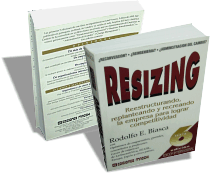
- The amount of years that the book has been sold.
If after three years of being published, the book is still sold, that is a clear hint that the content is valuable and not a fad.
Several of my books meet this criterion.
- “Resizing” (Spanish edition), was first published in 1991, it is still being sold.
- “Resizing” (Portuguese edition), was first published in 1995, it is still being sold.
- “Change Management”, was first published in 1998, it is still being sold.
- “Results. The Formula” and “Results. The Action”, published in 2000; they are still being sold. See Exhibit 119.
- “Are we competitive?” Published in year 2001, it is still being sold.
Books can be ordered online bookstores, publishers’ web sites and other places. More than three years in the market means success; five books meet this criterion.
- The name of the publisher .
In the US , it is not the same to be an author that publishes with McGraw-Hill that has world-wide distribution, that an author that publishes with an obscure publisher that prints study materials for a certain college.
The same happens in Spanish speaking countries, well-known and successful authors can publish with well-known publishers that sell all around Latin America and Spain , have their own offices in main Spanish-speaking countries ( Mexico , Spain , Argentina , Colombia , etc) and representatives in all the others.
If the reader goes to the publisher websites, it can be seen that at least three publishers meet this criterion:
These publishers have offices in main Latin American cities and Spain , and representatives all around Latin America.
Seven books, that are currently being sold, meet this criterion.
- The number and kind of places where the books are sold .
Books can be found in:
- Barnes & Noble. 13 titles found.
- Borders.
- Amazon.com. 10 titles found.
- abebooks.com. Important site that indicates where the booksellers. 47 titles are displayed.
- Powell’s books. 10 titles found.
- Bookamillion.com. 8 matches.
- Froogle (from Google). 30 titles.
|




